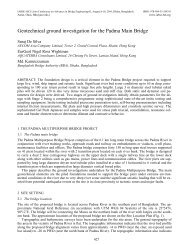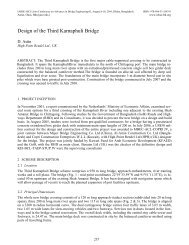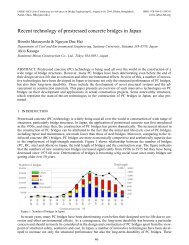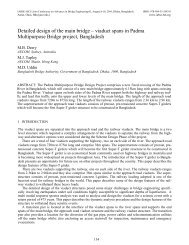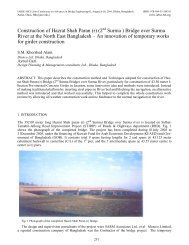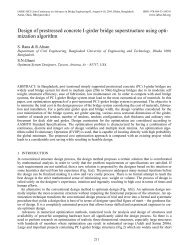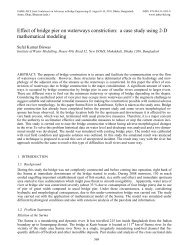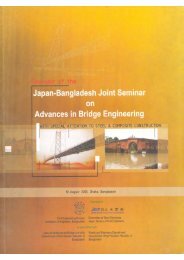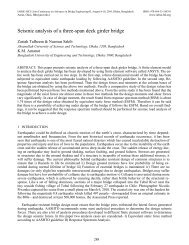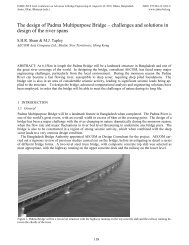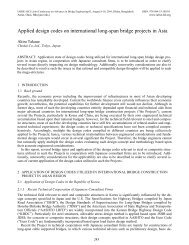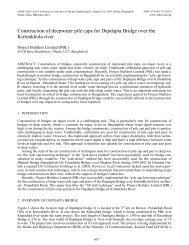Attributes of Ductile Reinforcing Steel M. Firoze - Bangladesh Group ...
Attributes of Ductile Reinforcing Steel M. Firoze - Bangladesh Group ...
Attributes of Ductile Reinforcing Steel M. Firoze - Bangladesh Group ...
Create successful ePaper yourself
Turn your PDF publications into a flip-book with our unique Google optimized e-Paper software.
IABSE-JSCE Joint Conference on Advances in Bridge Engineering-II, August 8-10, 2010, Dhaka, <strong>Bangladesh</strong>. ISBN: 978-984-33-1893-0<br />
Amin, Okui, Bhuiyan (eds.)<br />
www.iabse-bd.org<br />
<strong>Attributes</strong> <strong>of</strong> ductile reinforcing steel<br />
M. <strong>Firoze</strong><br />
Product Development & Marketing, BSRM <strong>Group</strong>, <strong>Bangladesh</strong><br />
1 INTRODUCTION<br />
Reinforced concrete is a composite material. By definition a material is composite if it is made <strong>of</strong> 2 different<br />
materials with highly divergent and even opposite properties. Manufactured concrete is excellent in compression<br />
and a lightweight material but brittle which make it useless in any member subjected to tensile forces. To<br />
overcome this steel bars are placed in concrete member zones where tensile forces are present. <strong>Steel</strong> has excellent<br />
tensile properties and highly ductile compared to concrete. Therefore a combination <strong>of</strong> steel and concrete<br />
confers unique properties to RCC which retains the most desirable characteristics <strong>of</strong> both the materials.<br />
As reinforced concrete is the mainstay <strong>of</strong> infrastructure and housing construction throughout the world,<br />
cement and reinforcing steel has emerged as major manufacturing industries in every country. This has led to<br />
codification <strong>of</strong> RCC construction practice throughout the world to simplify and streamline the design and<br />
construction process. This in turn has led to the standardization <strong>of</strong> material specifications for the construction<br />
industry. <strong>Reinforcing</strong> steel production is a major industrial segment in every country <strong>of</strong> the world. It is generally<br />
produced to national standards specification. As international trade has grown in volume and scope the<br />
demand for a material specification across major national standards has grown. The Geneva based International<br />
Standards Organization (ISO) under the tutelage <strong>of</strong> the World Trade Organization (WTO) played a pivotal<br />
role in the internationalization <strong>of</strong> material standards. Today the European Community nations follow<br />
common material specifications for thousands <strong>of</strong> items and reinforcing steel is no exception. Standardization<br />
<strong>of</strong> products to national and international specifications serves 3 useful purposes. First, it simplifies the exchange<br />
<strong>of</strong> goods as buyers and sellers have a common specification. Further, legal enforcement <strong>of</strong> contract<br />
specifications becomes easier and transparent. Most important the design pr<strong>of</strong>ession can prescribe material<br />
specification as per well defined norms which are available in the area.<br />
The international standard for reinforcing bar specification is ISO 6935. It has been adopted by the national<br />
reinforcing steel standards <strong>of</strong> the entire European Community <strong>of</strong> nations as well as Russia and all the<br />
CIS nation states. In Asia India, China and Japan along with the ASEAN nations has adopted the ISO based<br />
standards for steel and many other material standards as well. <strong>Bangladesh</strong> adopted the ISO standard in 2006.<br />
The strongest motivation, for this move is to remain globally competitive, by making a product for both the<br />
domestic and international market. It is worth mentioning that many <strong>of</strong> the nations adopting the ISO based<br />
standard are in the high seismic category. Among them are Turkey, Italy, and New Zealand. China and India<br />
both have areas <strong>of</strong> intense seismic activity.<br />
2 ISO AND ASTM STANDARDS<br />
Since many practicing engineers in <strong>Bangladesh</strong> are usually accustomed to using the U.S. based ASTM A-615<br />
re-bar standard the various grades in both the standards are compared for easy understanding.<br />
Table. 1 Strength comparisons <strong>of</strong> steel standards<br />
ASTM 615 ISO 6935<br />
Grade 40 [40,000 psi = 275 MPa]<br />
Grade 60 [60,000 psi = 415 MPa]<br />
Grade 75 [75,000 psi = 520 MPa]<br />
Grade 300 [300 MPa = 43,500 psi]<br />
Grade 400 [400 MPa = 58,000 psi]<br />
Grade 500 [500 MPa = 72,500 psi]<br />
237
There is another distinguishing feature <strong>of</strong> the ISO 6935, its restricted chemistry versus the open chemistry <strong>of</strong><br />
the ASTM A-615 standard which is tabulated below.<br />
Table.2 Chemistry <strong>of</strong> ASTM and ISO Standards<br />
Chemical Composition ASTM A 615<br />
Grade 60<br />
ISO 6935<br />
Grade 500W<br />
Carbon % No limit 0.24% Max<br />
Manganese %<br />
No limit<br />
1.65% Max<br />
Silicon %<br />
No limit<br />
0.60% Max<br />
Phosphorous%<br />
0.06% Max. 0.06% Max<br />
Sulphur %<br />
No limit<br />
0.06% Max<br />
Carbon Eqv.<br />
No limit<br />
0.51% Max<br />
3 DUCTILE GRADES OF STEEL<br />
Within the umbrella <strong>of</strong> the ISO 6935 standard a new generation <strong>of</strong> high strength reinforcing steels has been<br />
developed which is used in all high grade construction with safety and performance under adverse conditions<br />
<strong>of</strong> prime concern. The distinguishing feature <strong>of</strong> these steels is both the yield strength and ultimate strength<br />
have a minimum lower limit and maximum upper limit. This is clearly shown in the table below. In contrast<br />
the ASTM 615 bars had only minimum yield and ultimate strength requirements with no specified upper limits.<br />
The leading ductile or earthquake bar standards <strong>of</strong> several countries are compared in the table shown in<br />
the next page.<br />
Some <strong>of</strong> the more internationally recognized ‘<strong>Ductile</strong>’ also literally known as earthquake grades <strong>of</strong> steel are<br />
shown below<br />
Attribute ASTM 706<br />
Grade 60<br />
AS/NZS 4671<br />
Grade500E<br />
BS4449 Grade<br />
500C<br />
JIS G3112<br />
SD 490<br />
ORIGIN U.S.A. Australia-New Zealand<br />
U.K.<br />
Japan<br />
Yield strength, Fy,MPa<br />
540≥Fy≥420 600≥ Fy ≥500 650≥ Fy≥ 485 625≥Fy≥49<br />
0<br />
Ultimate strength Ts, MPa<br />
550 Min<br />
≥1.25Fy<br />
1.40Fy<br />
≥Ts≥1.15Fy<br />
1.38Fy≥Ts≥1.13F<br />
y<br />
620 Min<br />
Elongation Gauge<br />
Elongation: Fracture<br />
Elongation: Max. Force<br />
200 mm 5d 5d 5d<br />
10% – 14% -- -- 12% Min.<br />
-- ≥10% 6% Min. --<br />
4 THE FIVE MEASURES OF DUCTILITY<br />
The elongation at fracture is the most common and easily understood measure <strong>of</strong> ductility. It measures the total<br />
strain which the test specimen undergoes from the onset <strong>of</strong> loading to the point <strong>of</strong> rupture on a Universal<br />
Testing Machine (UTM). The elongation at maximum force is another measure <strong>of</strong> ductility which has gained<br />
currency in recent years. The elongation at maximum force is best understood by referring to the stress-strain<br />
graph shown below. It refers to the highest stress level shown on the y-axis <strong>of</strong> the graph. The corresponding<br />
strain on the x-axis <strong>of</strong> the graph is the elongation at maximum force. The 3 rd measure <strong>of</strong> ductility is the ratio<br />
<strong>of</strong> tensile stress to yield stress, which is a measure <strong>of</strong> strain hardening, under plastic deformation.<br />
238
Country<br />
SEISMIC STANDARDS<br />
Standard Quality Yield Tensile Elongation % Agt Re/Rm Carbon % Carbon Eq. %<br />
USA ASTM A 706 Gr 60 420-540 550 14 >1.25 0,30 0,55<br />
Australia AS 4671 GR 500 E 500-600 10 >1.15 - 1.40 0,22 0,50<br />
U.K. BS 4449 B 500 C 500-650 7,5 >1.15 - 1.15 - 1.15 - 1.13 - 1.15 - 1.15 - 1.15 - 1.15 - 1.15 - 1.40 0,22 0,50<br />
Canada<br />
CSA.G.30.18-M92<br />
Gr 400 400-525 560 13 >1.15 0,30 0,55<br />
Gr 500 500-625 625 12 >1.15 0,30 0,55<br />
Colombia NTC 2289 Diaco 60 420-540 550 14 >1.25 0,30 0,55<br />
Israel SI 4466-3 400 W 400-520 500 12 >1.25 0,24 0,55<br />
Venezuela<br />
Covenin 316<br />
W60 415-540 620 14 >1.25 0,30 0,55<br />
W70 490-637 620 14 >1.25 0,30 0,55<br />
EKSISMIK 500-650 600 8 >1.15 -
Fig.2 Bending Test<br />
Fig. 3 <strong>Ductile</strong> Rupture<br />
5 DESIGN CONSIDERATION<br />
Performance based RCC design dictates that structural elements form a plastic hinge under overload conditions.<br />
Further, the plastic hinge must be capable <strong>of</strong> undergoing large inelastic deformation with no significant<br />
reduction in load carrying ability. Structural designers would like to know the maximum strength <strong>of</strong> a plastic<br />
hinge zone so that other elements <strong>of</strong> a structure can be designed to remain elastic. For example, designers <strong>of</strong><br />
RCC buildings would want the beam to ‘fail’ by forming plastic overload hinges, in dissipating earthquake<br />
forces but not the columns. This is known as ‘strong column weak beam’ design to minimize loss <strong>of</strong> life in an<br />
earthquake. For such design the design engineers must know the minimum and maximum yield strength and<br />
the minimum and maximum tensile strengths <strong>of</strong> the reinforcing steels. Further, the use <strong>of</strong> higher strength steel<br />
relieves bar congestion in beam and column intersections, which is the most critical zone for safety from<br />
earthquakes. As the above ISO based bar standards place a definite lower and upper limit to the yield and tensile<br />
strength <strong>of</strong> the bar, probable over strength capacity <strong>of</strong> a plastic hinge can be inferred from test properties<br />
<strong>of</strong> the reinforcing steel manufactured to ISO standards.<br />
The U.S. government’s Federal Emergency Management Agency (FEMA) has advocated the following design<br />
strategy for improving the overall ductility <strong>of</strong> framed RC structures:<br />
Strategies to Improve Ductility<br />
• Use low flexural reinforcement ratio<br />
• Add compression reinforcement<br />
• Add confining reinforcement<br />
The above schematic diagram illustrates the Quench & Temper process which converts low carbon steel into<br />
500 MPa high strength bars with a guaranteed yield strength <strong>of</strong> 500 MPa.<br />
240
It consists in subjecting the hot rolled steel to an in-line heat treatment in 3 successive stages:<br />
• As soon as it leaves the final mill stand, the product is rapidly and energetically cooled through a short<br />
cooling installation, where it undergoes surface hardening (martensite layer)<br />
• As soon as this quenching operation is stopped, the surface layer is TEMpered by using the residual<br />
heat left in the CORE <strong>of</strong> the bar (self tempering <strong>of</strong> the martensite layer).<br />
• The third stage takes place while the product lies on the cooling bed where the bar is subjected to normal<br />
cooling down to ambient temperature (transformation <strong>of</strong> the residual austenite in the core)<br />
• The TTT diagram graphically explains the internal transformation in the micro-structure <strong>of</strong> the steel as<br />
it is rapidly cooled “quenched” for a precise interval and then naturally cooled at room temperature.<br />
Time Temperature Transformation (TTT) Diagram <strong>of</strong> the Q&T process<br />
The above process requires precise process control in the rolling mill as the quench process is time and temperature<br />
sensitive. The Quench and Temper process has clearly emerged as the preferred manufacturing route<br />
for reinforcing steel throughout the world due to the excellent combination <strong>of</strong> high strength and ductility <strong>of</strong><br />
the steel which is obtained through this process. The heat treated steel has a dual metallurgical structure, a<br />
s<strong>of</strong>t inner core and a hard outer casing.<br />
6 ECONOMY AND SAFETY<br />
As the construction industry demands greater economy and cost reductions in the face <strong>of</strong> ever rising price <strong>of</strong><br />
all types <strong>of</strong> construction material including steel reinforcements the demand for higher strength steel has gone<br />
up worldwide. All buildings and structures in the developed world and in the Middle East and in the ASEAN<br />
region are designed and built on high strength reinforcing steel manufactured through the heat treatment<br />
process. The reason is not only economic but better performance <strong>of</strong> the structure under adverse conditions <strong>of</strong><br />
earthquakes and storms.<br />
7 DUCTILE STEEL GRADES IN BANGLADESH<br />
In <strong>Bangladesh</strong> BSRM <strong>Steel</strong>s Ltd. was the first to introduce high strength ductile Grade 500 MPa yield<br />
strength steel reinforcement. The Grade 500 steel produced by BSRM is <strong>of</strong> the ductile or earthquake variety<br />
with controlled lower and upper limit yield strengths and the lower and upper limits in tensile strengths as<br />
well. It fully conforms to the internationally accepted U.K. bar standard B.S. 4449 Gr.500 and the Australia-<br />
New Zealand AS-ANZ 4671 Grade 500E and meets the major requirements <strong>of</strong> both the U.S. standard ASTM<br />
706 and the Japanese standard JIS G3112 SD 490 (typical Mill Test Reports enclosed)<br />
Traditionally construction in <strong>Bangladesh</strong> has relied on Grade 60 or 400 MPa strength steel for all types <strong>of</strong><br />
construction. The scenario changed rapidly with the introduction <strong>of</strong> Grade 500 steel last year by BSRM <strong>Steel</strong>s<br />
241
Ltd. As the use <strong>of</strong> Grade 500 steel reduces steel consumption by up to 15% compared to Grade 60 steel the<br />
introduction was an instant success. Many <strong>of</strong> the country’s top developers and designers <strong>of</strong> high rise buildings<br />
switched to Grade 500 for the inherent economy in the use <strong>of</strong> this grade <strong>of</strong> steel.<br />
It is worth mentioning that the monumental Bangabandhu Bridge over the mighty Jamuna River was built<br />
with a ductile grade <strong>of</strong> re-bar conforming to U.K. standard B.S. 4449. At the time no manufacturer in <strong>Bangladesh</strong><br />
had the means to produce any type <strong>of</strong> ductile reinforcements; the entire steel for the bridge was imported<br />
from Belgium and Turkey. In 2008 the cable stayed bridge over the river Karnafuli was built using BSRM<br />
ductile bar conforming to Grade 500<br />
242



